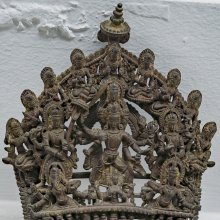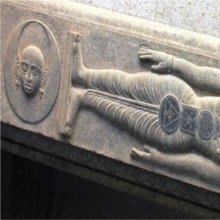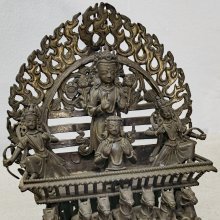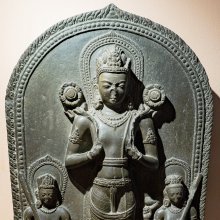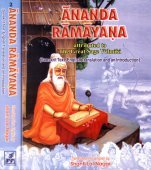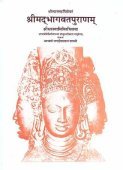Pingala, Piṅgalā, Piṅgala, Piṅgāla, Pimgala: 49 definitions
Introduction:
Pingala means something in Buddhism, Pali, Hinduism, Sanskrit, Jainism, Prakrit, the history of ancient India, Marathi. If you want to know the exact meaning, history, etymology or English translation of this term then check out the descriptions on this page. Add your comment or reference to a book if you want to contribute to this summary article.
Images (photo gallery)
In Hinduism
Shaivism (Shaiva philosophy)
Source: Wisdom Library: Ṣaṭsāhasra-saṃhitāPiṅgalā (पिङ्गला):—One of the twelve guṇas associated with Kanda, the fifth seat of the Svādhiṣṭhāna-chakra. According to tantric sources such as the Śrīmatottara-tantra and the Gorakṣasaṃhitā (Kādiprakaraṇa), these twelve guṇas are represented as female deities. According to the Ṣaṭsāhasrasaṃhitā however, they are explained as particular syllables. They (e.g. Piṅgalā) only seem to play an minor role with regard to the interpretation of the Devīcakra (first of five chakras, as taught in the Kubjikāmata-tantra).
Source: Wisdom Library: ŚaivismPiṅgala (पिङ्गल) is the name of a rākṣasa chief, presiding over Pātāla, according to the Parākhyatantra 5.44-45. Pātāla refers to one of the seven pātālas (‘subterranean paradise’). The word pātāla in this tantra refers to subterranean paradises for seekers of otherworldly pleasures and each the seven pātālas is occupied by a regent of the daityas, nāgas and rākṣasas.
The Parākhyatantra is an old Śaiva-siddhānta tantra dating from before the 10th century.
Source: Shodhganga: Iconographical representations of ŚivaPiṅgala (पिङ्गल) refers to one of the eighteen teachers of Āgama digests (paddhati) according to a theory where the sacred knowledge emanated from Śiva is said to have taught by Nandin to Sanaka, Sanātana, Sanandana and Sanatkumāra. Out of the four mutts established by them on the slopes of Himalayas, other eighteen mutts are established by Āgamic seers (e.g., Piṅgala), who authored the manuals named after their respective founders. The śaivāgama digests are termed as paddhati: manuals compiled by the teachers who have condensed the subject matter from the śloka-based Mūlāgamasand and presented them in the form of prayoga.

Shaiva (शैव, śaiva) or Shaivism (śaivism) represents a tradition of Hinduism worshiping Shiva as the supreme being. Closely related to Shaktism, Shaiva literature includes a range of scriptures, including Tantras, while the root of this tradition may be traced back to the ancient Vedas.
Natyashastra (theatrics and dramaturgy)
Source: Wisdom Library: Nāṭya-śāstra1) Piṅgala (पिङ्गल) is the Sanskrit name of one of Bharata’s sons, mentioned in the Nāṭyaśāstra 1.26-33. After Brahmā created the Nāṭyaveda (nāṭyaśāstra), he ordered Bharata to teach the science to his (one hundred) sons. Bharata thus learned the Nāṭyaveda from Brahmā, and then made his sons study and learn its proper application. After their study, Bharata assigned his sons (eg., Piṅgala) various roles suitable to them.
2) Piṅgala (पिङ्गल) is the name of a cloud whose sound corresponds to the Āliṅgya note made by drums (puṣkara) according to the Nāṭyaśāstra chapter 33. Accordingly, “after seeing that the Mṛdaṅgas, Paṇavas and Dardaras have been made, the great sage Svāti brought about a similarity of their notes with those of clouds... The cloud named Piṅgala gave note to Āliṅgya... Those who want Success of performances should make to these clouds, offerings which are dear to spirits (bhūta)”.

Natyashastra (नाट्यशास्त्र, nāṭyaśāstra) refers to both the ancient Indian tradition (shastra) of performing arts, (natya—theatrics, drama, dance, music), as well as the name of a Sanskrit work dealing with these subjects. It also teaches the rules for composing Dramatic plays (nataka), construction and performance of Theater, and Poetic works (kavya).
Purana and Itihasa (epic history)
Source: Wisdom Library: The Matsya-purāṇaPiṅgalā (पिङ्गला) is the name of a mind-born ‘divine mother’ (mātṛ), created for the purpose of drinking the blood of the Andhaka demons, according to the Matsya-purāṇa 179.8. The Andhaka demons spawned out of every drop of blood spilled from the original Andhakāsura (Andhaka-demon). According to the Matsya-purāṇa 179.35, “Most terrible they (e.g., Piṅgalā) all drank the blood of those Andhakas and become exceedingly satiated.”
The Matsyapurāṇa is categorised as a Mahāpurāṇa, and was originally composed of 20,000 metrical verses, dating from the 1st-millennium BCE. The narrator is Matsya, one of the ten major avatars of Viṣṇu.
Source: Wisdom Library: Varāha-purāṇaPiṅgala (पिङ्गल) is the name of a mountain situated at lake Asitoda and mount Vipula, according to the Varāhapurāṇa chapter 75. The Vipula mountain lies on the western side of mount Meru, which is one of the seven mountains located in Jambūdvīpa, ruled over by Āgnīdhra, a grandson of Svāyambhuva Manu, who was created by Brahmā, who was in turn created by Nārāyaṇa, the unknowable all-pervasive primordial being.
Source: archive.org: Puranic Encyclopedia1) Piṅgala (पिङ्गल).—A deva who is an attendant of the Sungod. Sūrya (Sun-god) rides in a one-wheeled chariot drawn by seven horses and he bears in his hands two lotuses. On his right side stands the attendant Daṇḍī with an ink-pot and a writing stick and on his left side stands the attendant Piṅgala with a stick. Both these are demi god attendants of Sūrya. (Chapter 51, Agni Purāṇa).
2) Piṅgala (पिङ्गल).—A prominent serpent born to the sage Kaśyapa of his wife Kadrū. (Śloka 9, Chapter 35, Ādi Parva).
3) Piṅgala (पिङ्गल).—A sage. He was a Yajvā (priest) in the Sarpasatra of Janamejaya. (Śloka 6, Chapter 53, Ādi Parva).
4) Piṅgala (पिङ्गल).—A King of the Yakṣas. He is a friend of Śiva. He acts as body-guard to Śiva who spends his time in cremation grounds. This Yakṣa gives happiness to all in the world. (Śloka 51, Chapter 23, Vana Parva).
5) Piṅgala (पिङ्गल).—A lion, who is a character in the book Pañcatantra. (See under Pañcatantra).
6) Piṅgala (पिङ्गल).—A brahmin of very bad manners. This brahmin was killed by his own wife who was a prostitute. In their next birth Piṅgala became a vulture and the prostitute, a parrot. Both had memories of their previous birth and the vulture (Piṅgala) with vengeance killed the parrot. After that Piṅgala was eaten one day by a tiger A brahmin residing on the shores of Gaṅgā read to their souls the fifth chapter of Gītā and they got salvation and entered Pitṛloka (world of the Manes). (Chapter 40, Sṛṣṭi Khaṇḍa, Padma Purāṇa).
7) Piṅgala (पिङ्गल).—A rākṣasa (demon). Once when this demon was going through a forest he met a forester. The latter got afraid and climbed up a Śamī tree. Then a branch broke and it fell on the head of Gaṇeśa sitting beneath that tree. It was an act of worship and because of that both the forester and the demon were elevated. (Gaṇeśa Purāṇa).
8) Piṅgalā (पिङ्गला).—A prostitute. (See under Ṛṣabha II).
9) Piṅgalā (पिङ्गला).—A prostitute of the country of Avantī. Piṅgalā was born as the daughter of King Candrāṅgada in her next birth because of the virtuous act she did in doing service to the sage Ṛṣabha. The King named the girl Kīrtimālinī and Bhadrāyu married her. (See under Bhadrāyu).
10) Piṅgalā (पिङ्गला).—A woman of the city of Ayodhyā. Once this woman approached Śrī Rāma with amorous intentions and Śrī Rāma who was strictly observing a vow of one-wife refused to satisfy her desire and said:—"During the incarnation of Kṛṣṇa you will be born as a servant maid of Kaṃsa and then I will in my form as Kṛṣṇa accept you." Sītā on hearing this cursed Piṇgalā. She said "Oh beautiful woman who has approached my husband with amorous intentions, you will have three bends in your body when you are born next as the servant maid of Kaṃsa." Piṅgalā weeping bitterly craved for pardon and then Sītā said that Kṛṣṇa would make her perfect. (Vilāsa Kāṇḍa, Ānanda Rāmāyaṇa).
Source: archive.org: Shiva Purana - English TranslationPiṅgala (पिङ्गल) is the name of a leader of Gaṇas (Gaṇapa or Gaṇeśvara or Gaṇādhipa) who came to Kailāsa, according to the Śivapurāṇa 2.1.20. Accordingly, after Śiva decided to become the friend of Kubera:—“[...] The leaders of Gaṇas revered by the whole world and of high fortune arrived there. [...] Another (leader of Gaṇas) Kākapāda with six crores and the lord Santānaka with six crores, Mahābala, Madhupiṅga and Piṅgala each with nine crores. [...]”.
These [viz., Piṅgala] and other leaders of Gaṇas [viz., Gaṇapas] were all powerful (mahābala) and innumerable (asaṃkhyāta). [...] The Gaṇa chiefs and other noble souls of spotless splendour eagerly reached there desirous of seeing Śiva. Reaching the spot they saw Śiva, bowed to and eulogised him.
Source: Cologne Digital Sanskrit Dictionaries: The Purana Index1a) Piṅgala (पिङ्गल).—One of the eleven Rudras.*
- * Matsya-purāṇa 153. 19; 171. 39.
1b) A door-keeper of the Sun God.*
- * Matsya-purāṇa 261. 5.
1c) A mountain west of the Śitoda.*
- * Vāyu-purāṇa 36. 27.
2a) Piṅgalā (पिङ्गला).—An aged prostitute of the Videha city; her story as narrated by Avadhūta to Yadu is as follows; she spent her life as a public woman living by earning money every day from one paramour or other; one night she did not get a paramour though she waited to the middle of the night; she then grew disgusted with her life and turned her thought on Hari which resulted in her restful sleep;1 her view of life cited by the Gopis to Uddhava.2
2b) An elephant (nāga).*
- * Brahmāṇḍa-purāṇa III. 7. 346.
2c) A śakti of Śri Mārutesvara.*
- * Brahmāṇḍa-purāṇa IV. 33. 70.
2d) A mind-born mother.*
- * Matsya-purāṇa 179. 23.
2e) Gave birth to Mahāpadma and Ūrmimāli; husband, candra or moon; these families were fond of elephant fighting; some of them were used in the war between the Devas and Asuras.*
- * Vāyu-purāṇa 69. 229 and 231.
Piṅgala (पिङ्गल) is a name mentioned in the Mahābhārata (cf. I.35.9, I.48.6, I.53) and represents one of the many proper names used for people and places. Note: The Mahābhārata (mentioning Piṅgala) is a Sanskrit epic poem consisting of 100,000 ślokas (metrical verses) and is over 2000 years old.
Source: Shodhganga: Kasyapa Samhita—Text on Visha Chikitsa (itihasa)Piṅgala is the name of a Serpent (sarpa) mentioned in the thirty-fifth chapter (verses 4-17) of the Ādiparva of the Mahābhārata.—Accordingly, Sauti, on being implored by Śaunaka to name all the serpents in the course of the sarpa-sattra, tells him that it is humanly impossible to give a complete list because of their sheer multiplicity; but would name the prominent ones in accordance with their significance [e.g., Piṅgala].

The Purana (पुराण, purāṇas) refers to Sanskrit literature preserving ancient India’s vast cultural history, including historical legends, religious ceremonies, various arts and sciences. The eighteen mahapuranas total over 400,000 shlokas (metrical couplets) and date to at least several centuries BCE.
Shilpashastra (iconography)
Source: Archaeological Survey of India: Śaiva monuments at Paṭṭadakal (śilpa)Piṅgala (पिङ्गल) is part of a sculpture of Sūrya (sun god) found at the temple of Lokeśvara, eastern porch ceiling.—In the upper portion of the tableau, by the side of the Sun are two makara, aquatic animals from the mouth of which are jutting out two human beings. Below these personages are seated two devotees, one on each side. They are Daṇḍin and Piṅgala. The former with a palm leaf book and a style is writing. On the snouts of aquatic reptiles are seated Śaṅkhanidhi and Padmanidhi. On the right hand side of the tableau, Mandeha, a group of demons who tried to attack the sun god, are taking to their heels. It is believed that they were taken aback when seven ascetics began to offer morning arghya, offering water respectfully to Sūrya. So these ascetics are shown on the right side of the god and on the left side are seen celestial beings offering flowers to him.
Source: Shodhganga: a concise history of Sanskrit Chanda literature (iconography)Piṅgala (पिङ्गल).—Dhīreśvarācārya, author of Vṛttamañjarī, who hailed from Assam puts an imaginary iconographical picture of Piṅgala, which is also peculiar in its nature. While offering his benediction to Piṅgala in the second chapter, he says “Piṅgala holds akṣasūtra in one of his hands, and kamaṇḍalu in another; wears a skin of black deer (ajina) with muñja girdle; possesses a sacred thread (upavīta) on his body”. He also says that “Piṅgala is adorned with brown clotted hair, which looks like burning fire”.
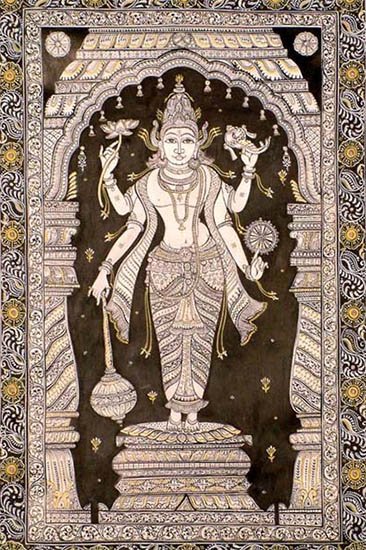
Shilpashastra (शिल्पशास्त्र, śilpaśāstra) represents the ancient Indian science (shastra) of creative arts (shilpa) such as sculpture, iconography and painting. Closely related to Vastushastra (architecture), they often share the same literature.
Jyotisha (astronomy and astrology)
Source: Wisdom Library: Brihat Samhita by Varahamihira1) Piṅgala (पिङ्गल) refers to the fifty-first of the sixty-year cycle of Jupiter, according to the Bṛhatsaṃhitā (chapter 8), an encyclopedic Sanskrit work written by Varāhamihira mainly focusing on the science of ancient Indian astronomy astronomy (Jyotiṣa).—Accordingly, “The five years of the eleventh yuga are—1. Piṅgala, 2. Kālayukta, 3. Siddhārtha, 4. Raudra, 5. Durmati. In the first year there will be much rain and fear from thieves and mankind will suffer from consumption of the lungs and the like asthmatic complaints. In the year Kālayukta mankind will suffer from various evils; but in Siddhārtha they will be happy in more ways than one. In the year Raudra mankind will suffer much and there will be loss and ruin in the land. In Durmati there will be moderate rain”.
2) Piṅgala (पिङ्गल) [=Daṇḍapiṅgalaka ?] (or Piṅgalaka) refers to a country belonging to “Uttaratas or Uttaradeśa (northern division)” classified under the constellations of Śatabhiṣaj, Pūrvabhādrapada and Uttarabhādrapada, according to the system of Kūrmavibhāga, according to the Bṛhatsaṃhitā (chapter 14).—Accordingly, “The countries of the Earth beginning from the centre of Bhāratavarṣa and going round the east, south-east, south, etc., are divided into 9 divisions corresponding to the 27 lunar asterisms at the rate of 3 for each division and beginning from Kṛttikā. The constellations of Śatabhiṣaj, Pūrvabhādrapada and Uttarabhādrapada represent the northern division consisting of [i.e., Daṇḍa, Piṅgala] [...]”.
Source: The effect of Samvatsaras: SatvargasPiṅgala (पिङ्गल) refers to the fifty-first saṃvatsara (“jovian year)” in Vedic astrology.—The native who is born in the ‘samvatsara’ named ‘pingala’ has yellowish eyes, is the doer of reprehensible or blameworthy deeds, is of fierce or extreme nature, restless, has grandeur or majesty, is bountiful or beneficent, stupid and harsh speaking (that is, speaks bitter words), remains happy, gets fame in the battle, is handsome, the minister of the King, is honoured by many and is capable or competent (powerful).
According with Jataka Parijata, the person born in the year pingala (2037-2038 AD) will be a saint with his mind under control and will engage in the practice of penances.

Jyotisha (ज्योतिष, jyotiṣa or jyotish) refers to ‘astronomy’ or “Vedic astrology” and represents the fifth of the six Vedangas (additional sciences to be studied along with the Vedas). Jyotisha concerns itself with the study and prediction of the movements of celestial bodies, in order to calculate the auspicious time for rituals and ceremonies.
Kavya (poetry)
Source: Wisdom Library: KathāsaritsāgaraPiṅgala (पिङ्गल) is the name of a king whose strength is considered as equaling a half-power warrior (ardharatha), according to the Kathāsaritsāgara, chapter 47. Accordingly, as the Asura Maya explained the arrangement of warriors in Sunītha’s army: “... [Piṅgala, and others], are considered half-power warriors”.
The story of Piṅgala was narrated by the Vidyādhara king Vajraprabha to prince Naravāhanadatta in order to relate how “Sūryaprabha, being a man, obtain of old time the sovereignty over the Vidyādharas”.
The Kathāsaritsāgara (‘ocean of streams of story’), mentioning Piṅgala, is a famous Sanskrit epic story revolving around prince Naravāhanadatta and his quest to become the emperor of the vidyādharas (celestial beings). The work is said to have been an adaptation of Guṇāḍhya’s Bṛhatkathā consisting of 100,000 verses, which in turn is part of a larger work containing 700,000 verses.
Source: Shodhganga: The Kavyamimamsa of RajasekharaPiṅgala (पिङ्गल) is the name of an important person (viz., an Ācārya or Kavi) mentioned in Rājaśekhara’s 10th-century Kāvyamīmāṃsā.—The first ācārya of Chanda Śāstra (Metrics) and probably a younger brother of Pānīni.

Kavya (काव्य, kavya) refers to Sanskrit poetry, a popular ancient Indian tradition of literature. There have been many Sanskrit poets over the ages, hailing from ancient India and beyond. This topic includes mahakavya, or ‘epic poetry’ and natya, or ‘dramatic poetry’.
Chandas (prosody, study of Sanskrit metres)
Source: Shodhganga: a concise history of Sanskrit Chanda literaturePiṅgala (पिङ्गल) is one of the authors of Sanskrit prosody that have enriched the Sanskrit literature through their various interpretations.—He is the founder of the school of Sanskrit Prosody similar to the Aṣṭādhyāyī of the great grammarian Pāṇini. He includes both the Vedic and Classical metres. Introducing six pratyayas, he gives an exhaustive interpretation to multiply the metres into numerous numbers. The work Chandaśśāstra is composed in sūtra form and divided into eight chapters. He expresses his views precisely in sūtra and presents all aspects of metres in his work.
Piṅgala is acclaimed as the son of Dākṣī, which endorses him to be the brother of Pāṇini (who is also known as Dākṣīputra). The famous tantric writer Bhāskararāya mentions Piṅgala as the son of Dākṣī in his Bhāṣyarāja, a metrical composition.
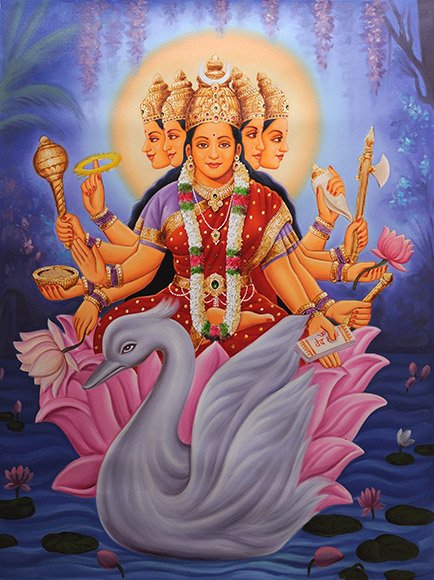
Chandas (छन्दस्) refers to Sanskrit prosody and represents one of the six Vedangas (auxiliary disciplines belonging to the study of the Vedas). The science of prosody (chandas-shastra) focusses on the study of the poetic meters such as the commonly known twenty-six metres mentioned by Pingalas.
Shaktism (Shakta philosophy)
Source: Google Books: Manthanabhairavatantram1) Piṅgalā (पिङ्गला) refers to one of the three channels (of vital breath) in the body hosting the deities Jyeṣṭhā and Viṣṇu.—In the Tantrasadbhāva we find the geometric shapes related to the energies, or aspects of the one energy, that constitute the Triangle. [...] These three energies are the consorts of the gods Brahmā, Viṣṇu and Maheśvara and manifest as a series of triads. At the microcosmic level they engender exhalation (equivalent to creation brought about by Vāmā), inhalation (equivalent to persistence brought about by Jyeṣṭhā) and retention of the breath (equivalent to withdrawal brought about by Raudrī). They are located in the corresponding channels in the body where these three forms of the vital breath function: namely Iḍā, Piṅgalā and Suṣumṇā, respectively. [...]”.
2) Piṅgala (पिङ्गल) refers to the color “brown”, according to the Ṣaṭsāhasrasaṃhitā, an expansion of the Kubjikāmatatantra: the earliest popular and most authoritative Tantra of the Kubjikā cult.—Accordingly, “(Pūrṇagiri) is on the northern peak of Kailāśa and is full of countless flames. Brilliant like ten million suns, it is as if devouring the Three Worlds. It is brown [i.e., piṅgala] and burning. Licking things up and destroying them, it is very terrible. O goddess, it is difficult for me to see it—what to say for others! It stands in the middle of the triangular city and is adorned with walls of lightning flashes. That divine city of the supreme Lord is made of pillars of adamantine. [...]”.
3) Piṅgala (पिङ्गल) is the name of the Youth (vaṭuka) associated with Pūrṇagiri, one of the sacred seats (pīṭha), according to the Ṣaṭsāhasrasaṃhitā, an expansion of the Kubjikāmatatantra: the earliest popular and most authoritative Tantra of the Kubjikā cult.
4) Piṅgala (पिङ्गल) refers to the Vaṭuka associated with Oḍḍiyāna, Jālandhara, Pūrṇagiri and Kāmarūpa, four of the eight Sacred Seats (pīṭha), according to the Yogakhaṇḍa (chapter 14) of the Manthānabhairavatantra, a vast sprawling work that belongs to a corpus of Tantric texts concerned with the worship of the goddess Kubjikā.
5) Piṅgala (पिङ्गल) refers to one of the twenty-one spheres of the rūpa state.—Chapter nineteen of the Kubjikāmatatantra begins with an exposition of the state called Form (rūpa). This is manifest in twenty-one spheres (cakra) [i.e., Piṅgala] of ‘millions’ (koṭi) of energies arranged along the axis of the head starting with the throat, up through the eyebrows and beyond. [...]
Source: academia.edu: The Śāradātilakatantra on YogaPiṅgalā (पिङ्गला) refers to the “right principle channel” and is explained in terms of kuṇḍalinīyoga by Lakṣmaṇadeśika in his 11th-century Śaradātilaka.—The body is described, starting from the “bulb” (kanda), the place in which the subtle channels (nāḍī) originate, located between anus and penis (28–9). The three principal channels are iḍā (left), piṅgalā (right) and suṣumṇā (in the centre of the spine and the head). Inside the suṣumṇā is citrā, a channel connecting to the place on the top of the skull called the brahmarandhra (30–4).

Shakta (शाक्त, śākta) or Shaktism (śāktism) represents a tradition of Hinduism where the Goddess (Devi) is revered and worshipped. Shakta literature includes a range of scriptures, including various Agamas and Tantras, although its roots may be traced back to the Vedas.
Vaishnavism (Vaishava dharma)
Source: Pure Bhakti: Arcana-dipika - 3rd EditionPiṅgalā (पिङ्गला) is the fifty-first of sixty years (saṃvatsara) in the Vedic lunar calendar according to the Arcana-dīpikā by Vāmana Mahārāja (cf. Appendix).—Accordingl, There are sixty different names for each year in the Vedic lunar calendar, which begins on the new moon day (Amāvasyā) after the appearance day of Śrī Caitanya Mahāprabhu (Gaura-pūrṇimā), in February or March. The Vedic year [viz., Piṅgalā], therefore, does not correspond exactly with the Christian solar calendar year.

Vaishnava (वैष्णव, vaiṣṇava) or vaishnavism (vaiṣṇavism) represents a tradition of Hinduism worshipping Vishnu as the supreme Lord. Similar to the Shaktism and Shaivism traditions, Vaishnavism also developed as an individual movement, famous for its exposition of the dashavatara (‘ten avatars of Vishnu’).
Dharmashastra (religious law)
Source: Prācyā: Animals and animal products as reflected in Smṛti textsPiṅgala (पिङ्गल) refers to a small kind of owl (Bubo bubo).—Birds have been described in several ancient Sanskrit texts that they have been treated elaborately by eminent scholars. These birds [viz., Piṅgala] are enumerated in almost several Smṛtis in context of specifying the expiations for killing them and their flesh being used as a dietary article to give satisfaction to the manes (Pitṛs) in Śrāddha rites. These are elaborated especially in the Manusmṛti, Parāśarasmṛti [chapter VI], Gautamasmṛti [chapter 23], Śātātapasmṛti [II.54-56], Uśānasmṛti [IX.10-IX.12], Yājñavalkyasmṛti [I.172-I.175], Viṣṇusmṛti [51.28-51.29], Uttarāṅgirasasmṛti [X.16].
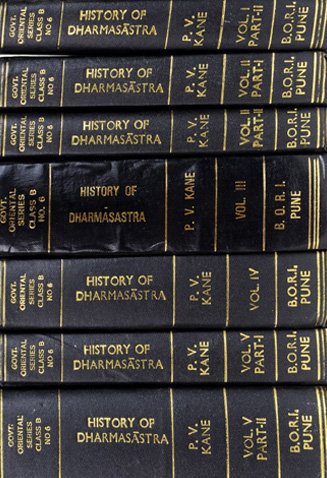
Dharmashastra (धर्मशास्त्र, dharmaśāstra) contains the instructions (shastra) regarding religious conduct of livelihood (dharma), ceremonies, jurisprudence (study of law) and more. It is categorized as smriti, an important and authoritative selection of books dealing with the Hindu lifestyle.
Vedanta (school of philosophy)
Source: Shodhganga: Siva Gita A Critical StudyPiṅgala (पिङ्गल) or Piṅgalagītā refers to one of the sixty-four Gītās commonly referred to in Hindu scriptures.—Gītā is the name given to certain sacred writings in verse (often in the form of a dialogue) which are devoted to the exposition of particular religious and theosophical doctrines. Most of these Gītās [i.e., Piṅgala-gītā] originate from the Mahābhārata or the various Purāṇas.
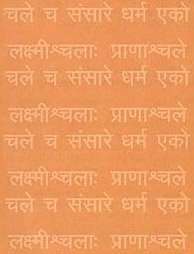
Vedanta (वेदान्त, vedānta) refers to a school of orthodox Hindu philosophy (astika), drawing its subject-matter from the Upanishads. There are a number of sub-schools of Vedanta, however all of them expound on the basic teaching of the ultimate reality (brahman) and liberation (moksha) of the individual soul (atman).
Ayurveda (science of life)
Veterinary Medicine (The study and treatment of Animals)
Source: Shodhganga: Portrayal of Animal Kingdom (Tiryaks) in Epics An Analytical studyPiṅgala (पिङ्गल) (lit. “one who is reddish brown tawny, yellow-coloured small kind of owl”) is a synonym (another name) for the Owl (Ulūka), according to scientific texts such as the Mṛgapakṣiśāstra (Mriga-pakshi-shastra) or “the ancient Indian science of animals and birds” by Hamsadeva, containing the varieties and descriptions of the animals and birds seen in the Sanskrit Epics such as the Ramayana and Mahabharata.

Āyurveda (आयुर्वेद, ayurveda) is a branch of Indian science dealing with medicine, herbalism, taxology, anatomy, surgery, alchemy and related topics. Traditional practice of Āyurveda in ancient India dates back to at least the first millenium BC. Literature is commonly written in Sanskrit using various poetic metres.
Ganitashastra (Mathematics and Algebra)
Source: archive.org: Hindu MathematicsPiṅgala (पिङ्गल) or Piṅgala refers to the “reddish-brown color” which were used as symbols for the unknowns, according to the principles of Bījagaṇita (“algebra” or ‘science of calculation’), according to Gaṇita-śāstra, ancient Indian mathematics and astronomy.—Āryabhaṭa I (499) very probably used coloured shots to represent unknowns. Brahmagupta (628) in the Brāhmasphuṭasiddhānta mentions varṇa as the symbols of unknowns. As he has not attempted in any way to explain this method of symbolism, it appears that the method was already very familiar. [...] In the case of more unknowns, it is usual to denote the first yāvattāvat and the remaining ones by alphabets or colours [e.g., piṅgalaka].—Cf. Pṛthūdakasvāmī (860) in his commentary on the Brāhmasphuṭasiddhānta by Brahmagupta (628) and Bhāskara II in the Bījagaṇita.
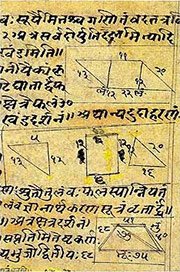
Ganitashastra (शिल्पशास्त्र, gaṇitaśāstra) refers to the ancient Indian science of mathematics, algebra, number theory, arithmetic, etc. Closely allied with astronomy, both were commonly taught and studied in universities, even since the 1st millennium BCE. Ganita-shastra also includes ritualistic math-books such as the Shulba-sutras.
General definition (in Hinduism)
Source: Oxford Index: HinduismOne of the three principal channels or nāḍī of yogic and Tantric physiologies, associated with the sun and the river Yamunā. It runs up the body to the left of the central channel (suṣumṇā) to the left nostril.
Source: Vic DiCara's Astrology: Hinduism“Saffron” (piṅgala) is not pinkish, it is a brownish yellow/orange.
In Buddhism
Theravada (major branch of Buddhism)
Source: Pali Kanon: Pali Proper Names1. Pingala. See Maha Pingala.
2. Pingala. A cow killing huntsman, a former birth of Alata. J.vi.227.
3. Pingala. King of Surattha, contemporary of Dhammasoka, whose adviser he was. One day, as Pingala was returning from Dhammasokas court, the peta Nandaka, father of Uttara, revealed himself and instructed him to follow the Buddhas teaching. Pv.iv.3; PvA.244ff.
4. Pingala. A race of elephants (MA.i.262; VibhA.397; UdA.403; AA.ii.822), each having the strength of one hundred thousand men. BuA.37.
-- or --
. A slave who, having made an assignation with her lover, as soon as her work was finished, waited outside her masters house, expecting his arrival. At the end of the middle watch, she gave up waiting and slept peacefully. This is one of the incidents mentioned in the Silavimamsa Jataka. J.iii.101.
Theravāda is a major branch of Buddhism having the the Pali canon (tipitaka) as their canonical literature, which includes the vinaya-pitaka (monastic rules), the sutta-pitaka (Buddhist sermons) and the abhidhamma-pitaka (philosophy and psychology).
Tibetan Buddhism (Vajrayana or tantric Buddhism)
Source: Wisdom Library: Tibetan Buddhism1) Piṅgalā (पिङ्गला) is the name of a deity summoned by the Yamāntaka-mantra and mentioned as attending the teachings in the 6th century Mañjuśrīmūlakalpa: one of the largest Kriyā Tantras devoted to Mañjuśrī (the Bodhisattva of wisdom) representing an encyclopedia of knowledge primarily concerned with ritualistic elements in Buddhism. The teachings in this text originate from Mañjuśrī and were taught to and by Buddha Śākyamuni in the presence of a large audience (including Piṅgalā).
2) Piṅgalā (पिङ्गला) is also the name of a Yakṣiṇī mentioned as attending the teachings in the 6th century Mañjuśrīmūlakalpa.
Source: De Gruyter: A Fragment of the VajrāmṛtamahātantraPiṅgalā (पिङ्गला) refers to one of the eight wisdoms (vidyās) described in the ‘śrīheruka-utpatti’ chapter of the 9th-century Vajrāmṛtatantra or Vajrāmṛtamahātantra: one of the main and earliest Buddhist Yoginītantras. Chapter 8 contains the description of how to visualise Śrīheruka [...] The great Vajra-holder should summon the Glorious form of Heruka, who is devouring the Devas together with Indra, Brahmā, Viṣṇu, and Śiva. Then the text lists the eight Wisdoms (vidyā) [viz., Piṅgalā], [...], expounds the words that the practitioner has to mutter when he is pushed by these wisdoms [...].
Source: academia.edu: A Critical Study of the Vajraḍākamahātantrarāja (II)Piṅgalā (पिङ्गला) is the name of a Goddess (Devī) presiding over Pretapura: one of the twenty-four sacred districts mentioned in the 9th century Vajraḍākatantra (chapter 18). Her weapon is the muṣala. Furthermore, Piṅgalā is accompanied by the Kṣetrapāla (field-protector) named Mahājaṅgha and their abode is the jaṭī-tree.

Tibetan Buddhism includes schools such as Nyingma, Kadampa, Kagyu and Gelug. Their primary canon of literature is divided in two broad categories: The Kangyur, which consists of Buddha’s words, and the Tengyur, which includes commentaries from various sources. Esotericism and tantra techniques (vajrayāna) are collected indepently.
Mahayana (major branch of Buddhism)
Source: archive.org: Bulletin of the French School of the Far East (volume 5)Piṅgala (पिङ्गल) is the name of an Asura appointed as one of the Divine protector deities of Avanti, according to chapter 17 of the Candragarbha: the 55th section of the Mahāsaṃnipāta-sūtra, a large compilation of Sūtras (texts) in Mahāyāna Buddhism partly available in Sanskrit, Tibetan and Chinese.—In the Candragarbhasūtra, the Bhagavat invites all classes of Gods and Deities to protect the Law [dharma?] and the faithful in their respective kingdoms of Jambudvīpa [e.g., the Asura Piṅgala in Avanti], resembling the time of the past Buddhas.

Mahayana (महायान, mahāyāna) is a major branch of Buddhism focusing on the path of a Bodhisattva (spiritual aspirants/ enlightened beings). Extant literature is vast and primarely composed in the Sanskrit language. There are many sūtras of which some of the earliest are the various Prajñāpāramitā sūtras.
In Jainism
General definition (in Jainism)
Source: archive.org: Trisastisalakapurusacaritra1) Piṅgala (पिङ्गल) refers to one of the nine treasures mentioned in chapter 1.4 [ādīśvara-caritra] of Hemacandra’s 11th century Triṣaṣṭiśalākāpuruṣacaritra: an ancient Sanskrit epic poem narrating the history and legends of sixty-three illustrious persons in Jainism.—Accordingly, “The King [Bharata] made a four days’ fast, directed toward the treasures, a guide on the path of acquisition of powers earned by former penance. At the end of the four days’ fast, the nine famous treasures approached him, each always attended by one thousand Yakṣas, Naisarpa, Pāṇḍuka, Piṅgala, Sarvaratnaka, Mahāpadma, Kāla, Mahākāla, Māṇava, Śaṅkhaka. They were mounted on eight wheels, eight yojanas high, nine yojanas broad, twelve yojanas long, their faces concealed by doors of cat’s-eye, smooth, golden, filled with jewels, marked with the cakra, sun, and moon. [...]”.
2) Piṅgala (पिङ्गल) is the son of Svāhā and Dhūmakeśa from Cakrapura, according to the Jain Ramayana and chapter 7.4 [Rāma and Lakṣmaṇa].—Accordingly, “[...] Devoted to pleasures, Kayāna wandered through the forest of existence for a long time and became the son, Piṅgala, of King Cakradhvaja’s chaplain, Dhūmakeśa by name, by his wife Svāhā, in the city Cakrapura. Piṅgala studied under one teacher with Atisundari, King Cakradhvaja’s daughter. As time passed, they became attached to each other; and Piṅgala seized her by a trick and went to the city Vidagdha. Packing in any skilled knowledge, he earned his living there by selling straw, wood, et cetera. For that is suitable for a worthless person”.

Jainism is an Indian religion of Dharma whose doctrine revolves around harmlessness (ahimsa) towards every living being. The two major branches (Digambara and Svetambara) of Jainism stimulate self-control (or, shramana, ‘self-reliance’) and spiritual development through a path of peace for the soul to progess to the ultimate goal.
India history and geography
Source: archive.org: Personal and geographical names in the Gupta inscriptionsPiṅgala (पिङ्गल) is an example of a name based on color heritge mentioned in the Gupta inscriptions. The Gupta empire (r. 3rd-century CE), founded by Śrī Gupta, covered much of ancient India and embraced the Dharmic religions such as Hinduism, Buddhism and Jainism. Derivation of personal names (e.g., Piṅgala) during the rule of the Guptas followed patterns such as tribes, places, rivers and mountains.

The history of India traces the identification of countries, villages, towns and other regions of India, as well as mythology, zoology, royal dynasties, rulers, tribes, local festivities and traditions and regional languages. Ancient India enjoyed religious freedom and encourages the path of Dharma, a concept common to Buddhism, Hinduism, and Jainism.
Languages of India and abroad
Pali-English dictionary
Source: BuddhaSasana: Concise Pali-English Dictionarypiṅgala : (adj.) brown; tawny.
Source: Sutta: The Pali Text Society's Pali-English DictionaryPiṅgala, (adj.) (see piṃsati1, cp. Vedic pingala) 1. reddishyellow, brown, tawny S. I, 170; J. VI, 199 (=pingiya). ‹-› 2. red-eyed, as sign of ugliness J. IV, 245 (as Np.; combd with nikkhanta-dāṭha); V, 42 (tamba-dāṭhika nibbiddha-pingala); Pv. II, 41 (=°locana PvA. 90; +kaḷāra-danta).—kipillaka the red ant DhA. III, 206.—cakkhutā redeyedness PvA. 250.—makkhikā the gadfly J. III, 263 (=ḍaṃsa) Nd2 268=SnA 101 (id.); SnA 33 (where a distinction is made between kāṇa-makkhikā and pingala°), 572 (=ḍaṃsa). (Page 457)

Pali is the language of the Tipiṭaka, which is the sacred canon of Theravāda Buddhism and contains much of the Buddha’s speech. Closeley related to Sanskrit, both languages are used interchangeably between religions.
Marathi-English dictionary
Source: DDSA: The Molesworth Marathi and English Dictionarypiṅgalā (पिंगला).—f S pop. or in poetry piṅgaḷā f A certain tubular vessel of the body. See under iḍā.
--- OR ---
piṅgaḷa (पिंगळ).—m piṅgaḷā m piṅgūḷa m A stinking kind of beetle. 2 Applied to a fellow who is always uttering something obscene or disgusting. And piṅgūḷa pādaṇēṃ To utter obscenity.
--- OR ---
piṅgaḷā (पिंगळा).—m (piṅgala S) Little spotted owl, Noctua Indica. 2 also piṅgaḷājōśī m A term for a description of fortuneteller who always predicts good.
--- OR ---
piṅgaḷā (पिंगळा) [or पिंगा, piṅgā].—a (piṅga S) Tawny, auburn, grayish;--used of the body, countenance, hair, eyes.
Source: DDSA: The Aryabhusan school dictionary, Marathi-Englishpiṅgaḷa (पिंगळ).—m piṅgaḷā m piṅgūḷa m A stinking kind of beetle. Little spotted owl.
--- OR ---
piṅgaḷā (पिंगळा) [or piṅgā, or पिंगा].—a Tawny, grayish.
Marathi is an Indo-European language having over 70 million native speakers people in (predominantly) Maharashtra India. Marathi, like many other Indo-Aryan languages, evolved from early forms of Prakrit, which itself is a subset of Sanskrit, one of the most ancient languages of the world.
Sanskrit dictionary
Source: DDSA: The practical Sanskrit-English dictionaryPiṅgala (पिङ्गल).—a. [piṅga-sidhmā° lac, piṅgaṃ lāti, lā-ka vā Tv.] Reddish-brown, yellowish, brown, tawny; तोनोत्तीर्य पथा लङ्कां रोधयामास पिङ्गलैः (tonottīrya pathā laṅkāṃ rodhayāmāsa piṅgalaiḥ) (vānaraiḥ) R.12.71; Manusmṛti 3.8; पिङ्गो दीपशिखाभः स्यात् पिङ्गलः पद्मधूलिवत् (piṅgo dīpaśikhābhaḥ syāt piṅgalaḥ padmadhūlivat).
-laḥ 1 The tawny colour.
2) Fire.
3) A monkey.
4) An ichneumon.
5) A small owl.
6) A kind of snake.
7) Name of an attendant on the sun.
8) Name of one of Kubera's treasures.
9) Name of a संवत्सर (saṃvatsara) (the 51st or 25th in the 6 years cycle).
1) Name of a reputed sage, the father of Sanskrit prosody, his work being known as पिङ्गलच्छन्दःशास्त्रः (piṅgalacchandaḥśāstraḥ); छन्दोज्ञाननिधिं जघान मकरो वेलातटे पिङ्गलम् (chandojñānanidhiṃ jaghāna makaro velātaṭe piṅgalam) Pañcatantra (Bombay) 2.33.
-lam 1 Brass.
2) Yellow orpiment.
-lā 1 A kind of owl.
2) The Śiśu tree (śiṃśapā).
3) A kind of metal.
4) A particular vessel of the body; Ch. Up.8.6.1.
5) The female elephant of the south.
6) Name of a courtezan who became remarkable for her piety and virtuous life. (The Bhāgvata mentions how she and Ajāmīla were delivered from the trammels of the world.)
--- OR ---
Piṅgāla (पिङ्गाल).—Carrot (Mar. gājara); Gīrvāṇa; also पिङ्गिमन् (piṅgiman).
Derivable forms: piṅgālam (पिङ्गालम्).
Source: Cologne Digital Sanskrit Dictionaries: Edgerton Buddhist Hybrid Sanskrit DictionaryPiṅgala (पिङ्गल).—m. (Sanskrit Lex. id., as Jain term; AMg. piṃgalaya), name of one of the four ‘great treasures’, Mahāvastu iii.383.19, or of the ‘king’ who guards it, Divyāvadāna 61.3; see s.v. elapatra; doubtless this guardian is the same as the nāga so named Mahāvyutpatti 3315; Mahā-Māyūrī 247.2; as name of a yakṣa Suvarṇabhāsottamasūtra 161.13 (?), see Kapila.
--- OR ---
Piṅgalā (पिङ्गला).—name of a rākṣasī: Mahā-Māyūrī 241.13; 243.16.
Source: Cologne Digital Sanskrit Dictionaries: Shabda-Sagara Sanskrit-English DictionaryPiṅgala (पिङ्गल).—mfn.
(-laḥ-lā-laṃ) Of tawny colour, brown, yellowish. m.
(-laḥ) 1. Tawny, (the colour,) a dull brown, or yellow. 2. An attendant upon the sun. 3. The sun. 4. A fabulous being in the form of a Naga or serpent of lower regions, to whom a treatise on prosody is ascribed; he hence considered as a Muni, or inspired and divine personage. 5. A name of Siva. 6. One of Kuvera'S divine treassures. 7. A monkey. 8. Fire. 9. An ichneumon. 10. A sort of poison. 11. A small owl. 12. The 51st year of the Hindu cycle. n.
(-laṃ) 1. Brass. 2. Yellow orpiment. f.
(-lā) 1. The female elephant of the south quarter. 2. A pious whore, commemorated in the Bhagavata. 3. A particular vessel of the body, the right of three canals which run from the os-coccygis; to the head, and which are the chief passages of breath and air, according to the anatomy of the Yoga school of philosophy. 4. An astrological house or period. 5. The Sisu tree, (Dalbergia Sisu.) 6. Heartpea. 7. A kind of owl. 8. A kind of metal. E. piji to colour, Unadi aff. alac; or piṅgala of a tawny hue, fem. aff. ṭāp.
Source: Cologne Digital Sanskrit Dictionaries: Benfey Sanskrit-English DictionaryPiṅgala (पिङ्गल).—[piṅga + la], I. adj., f. lā. 1. Of a tawny colour, brown, [Raghuvaṃśa, (ed. Stenzler.)] 12, 71; yellowish. 2. Red-eyed, [Mānavadharmaśāstra] 3, 8 ([Kullūka Schol. ed. [Mānavadharmaśāstra]]). Ii. m. A proper name. Iii. f. lā, A proper name.
Source: Cologne Digital Sanskrit Dictionaries: Cappeller Sanskrit-English DictionaryPiṅgala (पिङ्गल).—[adjective] = [preceding] [adjective]; [masculine] a man’s name, [especially] [Name] of an author on Chandas or metrics, [Epithet] of [several] gods & demons; [feminine] piṅgalā [adjective] kind of leech, a woman’s name.
Source: Cologne Digital Sanskrit Dictionaries: Monier-Williams Sanskrit-English Dictionary1) Piṅgala (पिङ्गल):—[from piñj] mf(ā and ī)n. (cf. [gana] gaurādi and kaḍārādi), reddish-brown, tawny, yellow, gold-coloured, [Atharva-veda] etc. etc.,
2) [v.s. ...] (in [algebra] also as Name of the 10th unknown quantity)
3) [v.s. ...] having r°-b° eyes, [Kātyāyana-śrauta-sūtra [Scholiast or Commentator]]
4) [v.s. ...] m. yellow colour, [Horace H. Wilson]
5) [v.s. ...] fire, [cf. Lexicographers, esp. such as amarasiṃha, halāyudha, hemacandra, etc.]
6) [v.s. ...] an ape, [cf. Lexicographers, esp. such as amarasiṃha, halāyudha, hemacandra, etc.]
7) [v.s. ...] an ichneumon, [cf. Lexicographers, esp. such as amarasiṃha, halāyudha, hemacandra, etc.]
8) [v.s. ...] a small kind of owl, [cf. Lexicographers, esp. such as amarasiṃha, halāyudha, hemacandra, etc.]
9) [v.s. ...] a small kind of lizard, [cf. Lexicographers, esp. such as amarasiṃha, halāyudha, hemacandra, etc.]
10) [v.s. ...] a species of snake, [Suśruta]
11) [v.s. ...] a [particular] vegetable poison, [cf. Lexicographers, esp. such as amarasiṃha, halāyudha, hemacandra, etc.]
12) [v.s. ...] (with Jainas) Name of a treasure
13) [v.s. ...] the 51st (or 25th) year in a 60 years' cycle of Jupiter, [Varāha-mihira]
14) [v.s. ...] Name of Śiva or a kindred being, [Gṛhya-sūtra; Gautama-dharma-śāstra] etc.
15) [v.s. ...] of an attendant of Śiva, [Kathāsaritsāgara]
16) [v.s. ...] of an attendant of the Sun, [cf. Lexicographers, esp. such as amarasiṃha, halāyudha, hemacandra, etc.]
17) [v.s. ...] of a Rudra, [Viṣṇu-purāṇa]
18) [v.s. ...] of a Yakṣa, [Mahābhārata]
19) [v.s. ...] of a Dānava, [Kathāsaritsāgara]
20) [v.s. ...] of a Nāga or serpent-demon, [Mahābhārata i, 1554] (the supposed author of the Chandas or treatise on metre regarded as one of the Vedāṅgas, identified by some with Patañjali, author of the Mahā-bhāṣya)
21) [v.s. ...] of sub voce ancient sages, [Mahābhārata; Rāmāyaṇa] etc.
22) [v.s. ...] m. [plural] Name of a people, [Mārkaṇḍeya-purāṇa]
23) Piṅgalā (पिङ्गला):—[from piṅgala > piñj] f. a species of bird, [cf. Lexicographers, esp. such as amarasiṃha, halāyudha, hemacandra, etc.]
24) [v.s. ...] a kind of owl, [Varāha-mihira]
25) [v.s. ...] Dalbergia Sissoo, [cf. Lexicographers, esp. such as amarasiṃha, halāyudha, hemacandra, etc.]
26) [v.s. ...] = karṇikā, [cf. Lexicographers, esp. such as amarasiṃha, halāyudha, hemacandra, etc.]
27) [v.s. ...] a kind of brass, [cf. Lexicographers, esp. such as amarasiṃha, halāyudha, hemacandra, etc.]
28) [v.s. ...] a [particular] vessel of the body (the right of 3 tubular vessels which according to the Yoga philosophy are the chief passages of breath and air; cf. [Chāndogya-upaniṣad viii, 6, 1])
29) [v.s. ...] a kind of yellow pigment (= go-rocanā), [cf. Lexicographers, esp. such as amarasiṃha, halāyudha, hemacandra, etc.]
30) [v.s. ...] Name of Lakṣmī, [Demetrius Galanos’s Lexiko: sanskritikes, anglikes, hellenikes]
31) [v.s. ...] of a courtezan who became remarkable for her piety, [Mahābhārata]
32) [v.s. ...] of the female elephant of the South quarter, [cf. Lexicographers, esp. such as amarasiṃha, halāyudha, hemacandra, etc.]
33) [v.s. ...] of an astrological house or period, [Horace H. Wilson]
34) [v.s. ...] heart-pea, [Horace H. Wilson]
35) Piṅgala (पिङ्गल):—[from piñj] n. a [particular] metal, [cf. Lexicographers, esp. such as amarasiṃha, halāyudha, hemacandra, etc.]
36) [v.s. ...] yellow orpiment, [cf. Lexicographers, esp. such as amarasiṃha, halāyudha, hemacandra, etc.]
Source: Cologne Digital Sanskrit Dictionaries: Yates Sanskrit-English DictionaryPiṅgala (पिङ्गल):—[(laḥ-lā-laṃ) a.] Tawny. m. Tawny colour; the sun; or his attend- ant; a Nāga; Shiva; one of Kuvera's treasures; a monkey; fire; ichneumon; poison; owl; 51st year of the Hindu cycle. f. Elephant in the south quarter; a whore; a tubular vessel; astrological period; Sisu tree; heartpea. n. Brass; yellow orpiment.
Source: DDSA: Paia-sadda-mahannavo; a comprehensive Prakrit Hindi dictionary (S)Piṅgala (पिङ्गल) in the Sanskrit language is related to the Prakrit word: Pigaṃla.
[Sanskrit to German]
Sanskrit, also spelled संस्कृतम् (saṃskṛtam), is an ancient language of India commonly seen as the grandmother of the Indo-European language family (even English!). Closely allied with Prakrit and Pali, Sanskrit is more exhaustive in both grammar and terms and has the most extensive collection of literature in the world, greatly surpassing its sister-languages Greek and Latin.
Kannada-English dictionary
Source: Alar: Kannada-English corpusPiṃgala (ಪಿಂಗಲ):—[adjective] of reddish brown.
--- OR ---
Piṃgala (ಪಿಂಗಲ):—
1) [noun] the reddish brown colour.
2) [noun] the light red colour.
3) [noun] the colour of the gold; yellow colour.
4) [noun] (myth.) name of one of the attendants of the Sun-god.
5) [noun] the small owl Athene brama of Strigidae family, with large yellow eyes, with grey-spotted white breast, small, hooked beak, grey legs, short tail; spotted owlet.
6) [noun] the fifty first year in the Hindu cycle of sixty years.
7) [noun] (myth.) name of a fabulous serpent.
8) [noun] (jain.) one of the nine kinds of treasures (believed to bestow superior crown, ear ornaments, necklace, etc. to an emperor).
9) [noun] the tree Dalbergia sisso ( = D. sissosa, = D. sissu) of Papilionaceae family.
--- OR ---
Piṃgaḷa (ಪಿಂಗಳ):—[adjective] = ಪಿಂಗಲ [pimgala]1.
--- OR ---
Piṃgaḷa (ಪಿಂಗಳ):—[noun] = ಪಿಂಗಲ [pimgala]2.
--- OR ---
Piṃgaḷa (ಪಿಂಗಳ):—[noun] = ಪಿಂಗಲೆ - [pimgale -] 3.
Kannada is a Dravidian language (as opposed to the Indo-European language family) mainly spoken in the southwestern region of India.
See also (Relevant definitions)
Starts with (+40): Pimgalanadi, Pimgalayana, Pingala Buddharakkhita, Pingalabhavoddyota, Pingalabhru, Pingalacarya, Pingalacchandahsutra, Pingalacchandas, Pingalacchandovritti, Pingalacchandovrittivyakhya, Pingalachandahsutra, Pingalachandasara, Pingalachhandasara, Pingalagandhara, Pingalagita, Pingalajya, Pingalaka, Pingalakanva, Pingalakoccha, Pingalaksha.
Ends with (+8): Abhipingala, Anantapingala, Apingala, Babhrupingala, Dandapingala, Diptapingala, Ekapingala, Gandhapingala, Haripingala, Hemapingala, Ishatpingala, Kalapingala, Kanakapingala, Kapingala, Keshapingala, Krishnapingala, Madhupingala, Mahapingala, Manapingala, Nilapingala.
Full-text (+428): Paingala, Krishnapingala, Diptapingala, Paingalayana, Pingalika, Bhujamgesha, Sushumna, Paingalayani, Pingalamata, Pingalatantra, Pingalasutra, Chandahsutra, Paingalya, Chandasshastra, Shvetapingala, Vatsajiva, Ekapingala, Pangulakida, Bhogada, Makkhika.
Relevant text
Search found 86 books and stories containing Pingala, Pimgala, Piṃgala, Piṃgaḷa, Piṅgalā, Piṅgala, Piṅgaḷa, Piṅgaḷā, Piṅgāla; (plurals include: Pingalas, Pimgalas, Piṃgalas, Piṃgaḷas, Piṅgalās, Piṅgalas, Piṅgaḷas, Piṅgaḷās, Piṅgālas). You can also click to the full overview containing English textual excerpts. Below are direct links for the most relevant articles:
Sahitya-kaumudi by Baladeva Vidyabhushana (by Gaurapada Dāsa)
Text 9.26 < [Chapter 9 - Ornaments of Sound]
Chandogya Upanishad (english Translation) (by Swami Lokeswarananda)
Verse 8.6.1 < [Section 8.6]
Manusmriti with the Commentary of Medhatithi (by Ganganatha Jha)
Verse 3.8 < [Section III - Marriageable Girls]
Verse 9.42 < [Section III - To whom does the Child belong?]
Verse 1.21 < [Section IX - Creation of the World from ‘Mahat’ downwards]
The Skanda Purana (by G. V. Tagare)
Chapter 247 - Greatness of Piṅgalāditya, Piṅgādevī and Śukreśvara < [Section 1 - Prabhāsa-kṣetra-māhātmya]
Chapter 81 - Piṅgaleśvara (piṅgalā-īśvara-liṅga) < [Section 2 - Caturaśīti-liṅga-māhātmya]
Chapter 184 - The Yajña of Brahmā: The Third Day < [Section 1 - Tīrtha-māhātmya]
Bhakti-rasamrta-sindhu (by Śrīla Rūpa Gosvāmī)
Verse 4.5.28 < [Part 5 - Anger (raudra-rasa)]
Verse 2.1.358 < [Part 1 - Ecstatic Excitants (vibhāva)]
Jnaneshwari (Bhavartha Dipika) (by Ramchandra Keshav Bhagwat)
Verse 18.52 < [Chapter 18 - Moksha-sannyasa-yoga]
Verse 6.14 < [Chapter 6 - Dhyana-yoga]
Verse 18.33 < [Chapter 18 - Moksha-sannyasa-yoga]
Related products
